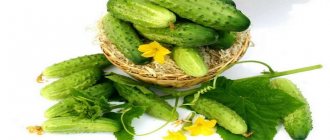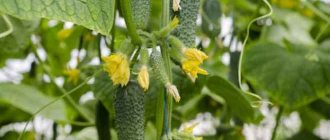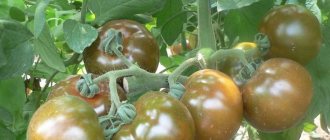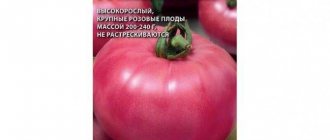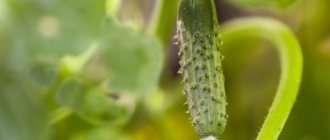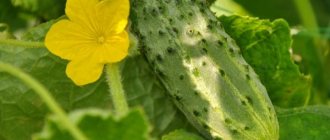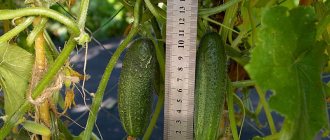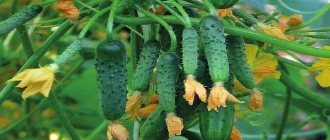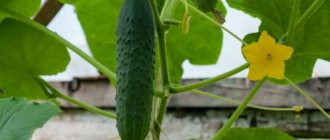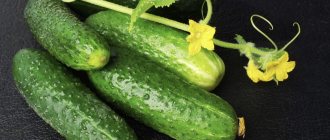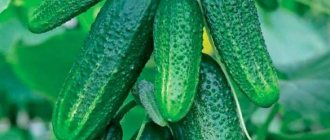Every year, on the eve of the new season, gardeners visit seed stores, wanting to replenish their arsenal with new products or already favorite varieties. They also don’t shy away from the counter with seeds of hybrid cucumbers, often choosing them: the yield is higher, and they don’t respond with bitterness to every whim of the weather. Many advertised expensive new products do not live up to expectations. We have to turn to already proven and proven hybrids. Reviews of Zhuravlenok F1 cucumbers leave a good impression, so they are a frequent choice of farming enthusiasts.
Description of cucumber Crane F1
The hybrid cucumber variety Zhuravlenok F1 was created at the Crimean Experimental Breeding Station, which is a branch of VIR. She is the patent holder for the production and distribution of its seeds. When entered into the State Register in 1996, it was recommended for cultivation in almost all regions for planting in open ground and in greenhouses. Reviews of the cucumber variety Zhuravlenok F1 indicate that in regions with cool climates it fully reveals its potential under temporary film covers.
Characteristics of the variety:
- the ripening time of the Zhuravlenok F1 cucumber is mid-early, the first cucumbers can be harvested already 45 days after germination;
- to set fruit it needs pollination by bees;
- the main vine of the Zhuravlenok F1 cucumber is long - up to 190 cm, the side vines are 3-5 cm, the cucumber needs to be shaped and pinched;
- fruiting is long - the fruits ripen until frost;
- Zhuravlenka F1 cucumbers have the same size - length from 11 to 12 cm and thickness no more than 4 cm and elliptical shape;
- the tubercles on the matte dark green skin of the cucumber are large, the pubescence is sparse, the spines are black;
- Two-thirds of the length of the fruits of the hybrid cucumber variety Zhuravlenok F1 is covered with light stripes with blurred boundaries.
It is impossible not to mention the high resistance of Zhuravlenka to a number of diseases of pumpkin crops, both fungal and viral in nature:
- bacteriosis;
- ordinary cucumber mosaic;
- powdery mildew.
To peronosporosis - downy mildew, Crane F1 is tolerant. This means that he can be affected by it, but this does not affect the harvest.
Reviews
The hybrid Crane appeared more than 20 years ago and managed to win the love of large farmers and summer residents due to its ease of planting and care, excellent taste and high productivity.
Valery, Liski: “I constantly plant Zhuravlenok cucumbers in the garden at the dacha. There were never any problems. The crop rarely gets sick and is not demanding on the composition of the soil. I installed drip irrigation on the site and covered it with agrofibre. The fruits are very juicy and crispy, the skin is thin, not hard.”
Irina, Vladimir: “I’ve been familiar with the hybrid for a long time, I grow it in a greenhouse and in the garden, if there is room for planting. Since the cucumber is bee-pollinated, the pollen has to be transferred manually. This applies to bushes in a greenhouse. In open ground there are no these problems. I like the culture for its unpretentiousness and the ability to harvest until late autumn. The cucumbers are juicy, dense, ideal for pickling, despite their thin skin.”
Pros and cons of the cucumber variety Zhuravlenok F1
This hybrid variety of cucumbers has many more advantages than disadvantages:
- fairly early and long-term fruiting;
- excellent taste;
- disease resistance;
- high yield for a bee-pollinated variety;
- bunch fruiting.
For some gardeners, the large length of the cucumber vine of the Zhuravlenok F1 cucumber is a disadvantage: it is inconvenient to move around the beds. Others consider it an advantage: a long lash means a lot of cucumbers. Crane F1 should be spread out only in open ground; it will require formation in a greenhouse. This can be considered a disadvantage, but without this operation you cannot get a significant harvest from either the variety or the hybrid. Correctly formed plants of the Zhuravlenok cucumber variety, as in the photo, are hung with fruits.
Advantages and disadvantages
The hybrid is universal, good for preparing salads and preserves. The characteristics and positive aspects are as follows:
- high taste qualities;
- resistance to most cucumber diseases;
- good yield;
- ease of care;
- resistance to temperature fluctuations;
- excellent presentation;
- growing in any type of soil;
- affordable price of planting material.
The variety practically does not require preventive measures. Only in the beginning, before planting, is it recommended to fertilize the soil with organic or mineral-type compounds.
Among the disadvantages, experienced gardeners note large shoots that require garters and support. Carrying out manipulations causes a lot of trouble, including during harvesting.
Optimal growing conditions
Cucumbers originate from India, where it is warm and humid. Over many years of selection, they have adapted to the climate of the risky farming zone, but still need warmth and moisture. They also have other requirements:
- full sunlight all day long, only a few hybrids can grow in partial shade, but Crane F1 is not one of them;
- sufficient feeding area - you need to plant cucumbers of this hybrid in a row no more often than every 40 cm, and maintain a distance of 80 cm between rows; in open ground or more - the Crane's vines are long, they need a lot of space;
- loose fertile soil with a high humus content and neutral or slightly lower acidity.
Important! Cucumbers of the Zhuravlenok variety, unlike most garden crops, have a positive attitude towards the application of fresh manure. To grow a large leaf mass you need a lot of nitrogen, of which it is a source.
- Regular watering of Zhuravlenok F1 cucumbers with warm water: when the top layer of soil, where the roots are located, dries out, growth and fruiting slow down.
Advice! If cucumbers have a lot of barren flowers, slightly drying the soil stimulates the formation of female flowers. - high air humidity, in the range of 85-90%, and a high content of carbon dioxide, which improves photosynthesis;
- regular feeding, both root and foliar.
To obtain a good harvest of Zhuravlenok F1 cucumbers, it is especially important to observe the temperature regime:
- in clear weather + 25-29 °C;
- on cloudy days + 20-22 °C.
Attention! At night, the temperature should not drop below 20 °C - this is when the harvest grows.
If it is hot and the temperature outside or in the greenhouse is more than 30 °C, the pollen becomes sterile and there will be no ovaries. Cucumbers will not set if the temperature drops below 15 °C, despite abundant flowering.
Landing Features
Cucumber Mullet f1 can be planted in different ways: both seed and seedlings. The main thing is that the soil is warm enough at the time of planting, and the weather is sunny and warm. This variety, according to the description, loves light and ripens much faster in warm climates.
Landing dates
Mid-season red mullet begins to be planted for seedlings in late April. The formed sprouts are transplanted into the greenhouse in mid-May. It is better to plant cucumbers in open ground at the very end of May, or at the beginning of June - depending on weather conditions.
Site preparation
The area for cucumbers has been dug up deeply since the fall and fertilized with organic matter. A few days before planting, repeated loosening and fertilizing will be required - with compost, manure, or mineral fertilizers. Holes for cucumbers are dug to a depth of 40 cm, and fertilizer is added to each hole: compost or ash.
The ideal soil for Mullet f1, as described, is medium loamy, well loosened for sufficient ventilation - the sprouts will need a lot of oxygen. In the greenhouse, the first layer of soil before planting Red Mullet f1 must be completely replaced.
Planting seeds
The variety can be planted with seeds in open ground or a greenhouse only if the climate is sufficiently warm and stable. The seeds are added, according to the description, at the end of April, into previously prepared holes.
3 days before planting, the holes are filled with hot water. Before sowing, the seeds themselves are soaked for 40 minutes in a saline solution and disinfected with a solution of potassium permanganate. To ensure that cucumbers develop good immunity, they can be further hardened on the bottom shelf of the refrigerator.
Planting seedlings
The most common and safest way to plant cucumbers. Red mullet f1, according to the description, is planted after the appearance of 4-5 leaves, when the height of the sprouts reaches 8-10 cm. Before transplanting into the ground, red mullet seedlings should be treated with fungicides.
For planting work, it is recommended to choose a clear, windless day. Cucumber sprouts are transferred to the soil very carefully - their roots are quite fragile and easily damaged.
Planting scheme
The best distance for red mullet sprouts is 50 cm between neighboring bushes and the same amount between rows. Thus, there will be 3 bushes per 1 m². During the process of growth and maturation, the weakest plants of the variety will need to be removed so that they do not take away beneficial substances from stronger and more promising ones.
Growing cucumbers Crane F1
Zhuravlenok F1 cucumbers can be grown by seedlings and sowing seeds in open ground. Each of these methods has its own advantages. Experienced gardeners combine them, extending the harvest season.
Direct planting in open ground
Start sowing the seeds of Zhuravlenok F1 cucumbers when the ground becomes warm - its temperature should not be less than + 15 ° C. It is important that the spring frosts are already behind us. Features of planting cucumber seeds Zhuravlenok F1:
- choose a place where representatives of the pumpkin family have not grown for several years;
- Cucumbers grow best in a warm bed, if it is impossible to build one, for every square meter.
m add up to 2 buckets of compost or humus and a matchbox of nitrophoska; Important! Fertilizer and humus are distributed over the entire area of the bed - the root system of Zhuravlenok F1 cucumbers is shallow, but branched. - You can sow the seeds of the Crane cucumbers either dry or pre-soaked, if they are not treated with thiram, they are colored;
Important! The latter method is preferable, but the bed with crops will have to be kept moist. - sowing depth – 1.5-2 cm.
Advice! To prevent birds from pecking out cucumber seeds, which happens often, it is better to cover the bed with non-woven material, at the same time the moisture will be better preserved.
Cucumbers sprout quickly in warm soil; their cotyledon leaves will appear in 3-4 days.
Growing by seedlings
When growing Zhuravlenok F1 cucumber seedlings, the harvest can be obtained a month earlier. But it makes sense to do it if there is a well-lit windowsill or the opportunity to provide additional light to the plants: you won’t get a big harvest from stretched seedlings.
Stages of growing seedlings:
- soak the seeds of the Zhuravlenok F1 cucumbers until they peck;
- prepare containers - peat pots or tablets, or, in extreme cases, cups that can be easily cut before replanting.
Attention! Plants of the Zhuravlenok F1 variety react negatively to damage to the roots, so they need to be planted very carefully and should not be picked.
- The soil for sowing cucumbers should be light and moderately fertile. You can buy ready-made or mix turf soil, peat and sand in equal parts, adding vermicult.
- Cucumber seeds are planted in separate containers to a depth of 1.5 cm to provide them with greenhouse conditions; the containers are hidden in a plastic bag, which is removed when the cotyledons appear.
- Conditions for keeping Zhuravlenka F1 seedlings – 12 hours of daylight, temperature + 20-25 °C, watering with warm water and careful loosening.
Plants are planted in the ground at the age of 3-4 weeks, from here you need to determine the timing of sowing: everyone’s climate is different. By this time, Crane F1 should have 3-4 true leaves and a strong stem. To prevent the seedlings from experiencing stress due to a sudden change in habitat, they are gradually accustomed to outdoor conditions for a week.
Watering and fertilizing
This is the main thing that the F1 Crane needs after landing.
Water the plants only with water heated in the sun, as soon as the top layer of soil dries out slightly. You need to wet it to a depth of 20 cm.
Advice! The entire area of the garden bed should be watered.
Cucumbers should not be watered at night or in the middle of a sunny day. In the first case, this is a path to fungal diseases, in the second, leaf burns cannot be avoided.
Cucumbers are fed frequently, but the concentration of fertilizers should be lower than for other crops.
Even if the bed is well filled with organic matter, Zhuravlenok F1 needs additional mineral fertilizing: 30 g per bucket of complex mineral fertilizer, per square meter. m is enough 3 liters. They are alternated with an infusion of mullein (diluted 10 times, infuse and take 3 liters per bucket) or bird droppings (dilute 25 times, 3 liters per bucket). This amount is enough to feed a square. m of bed area. The frequency of feeding is once every 10-15 days. They require watering before.
Cucumbers respond well to foliar feeding with weak fertilizer solutions: 10 g of urea and 6 g of potassium sulfate per 10 liters. Plants are sprayed on the leaves in cloudy, windless weather.
Formation
It is especially necessary when growing Crane F1 on a trellis so that the plants are compact. As soon as the main stem begins to grow, it is tied to a trellis and shaped according to the following pattern:
In open ground, when spreading a crop, they do it differently - they pinch off the main shoot if it has grown too much and interferes with the vegetables in the neighboring beds. Since the ovaries are uniformly formed both on the main stem and on the side vines, the Zhuravlenok F1 variety does not need any other formation.
Disembarkation and care
Stage 1. Planting in a garden bed or greenhouse
| |
Stage 2. Constant watering
| |
Stage 3. Periodic application of fertilizers
| |
Stage 4. Plant staking
| |
Stage 5. Treatment against diseases and pests
| |
Stage 6. Timely harvesting
|
Diseases and pests
Of the fungal diseases, the most dangerous for Crane F1 are root rot and downy mildew. As a preventive measure against rotting of the root zone of the stem, you can sprinkle it with sand when planting. For treatment, dusting with drying substances is used - crushed charcoal, ash or chalk.
To prevent peronosporosis, phytosporin is used (twice treatment according to instructions); for treatment, copper-containing fungicides are used.
Advice! Experienced gardeners use whey for this: spraying solution: a liter of whey or curdled milk per bucket of water, 10 drops of iodine and tbsp. spoon of liquid soap.
Infusions of onion and garlic are used against aphids on cucumbers - 90 g per bucket or hot pepper - 30 g per bucket. Per sq. I need 2 liters of infusion.
Slugs and whiteflies are controlled using traps. For slugs, pieces of boards are laid out on the beds and insects are collected by hand. Whiteflies are caught with sticky traps.
Description of the variety
Cucumbers of this variety are early ripening - about 41-45 days pass from the first shoots to harvest. The growth of the main stem is intense and can reach a height of up to 190 cm. The plant itself is climbing and can be overgrown with many side shoots.
The cucumbers themselves grow in the correct shape, smooth, slightly ribbed. There are large tubercles on the surface. A brief description of the fruit is as follows: length - 11-12 cm, weight - 80-110 g, diameter - 3.5-4 cm. There are slightly noticeable white stripes on the skin, which can reach the middle of the fruit.
Since the greens are covered with a large number of black thorns, it is better to pick the fruits with gloves. But the flesh of these cucumbers is juicy, crispy and tender at the same time.
The “Crane F1” cucumber is characterized by only positive reviews: gardeners note that there are no voids in the fruits, making them excellent for pickling and pickling.
There can be up to 5 ovaries on one leaf axil, so the yield of this variety is quite good - from 7 to 10 kg per square meter of planting. You can fit 3-4 plants on one meter - it is at this density that you can achieve maximum yield.
Reviews of Zhuravlenok F1 cucumbers
Irina Moskvina, 45 years old, Krasnodar
I love bee-pollinated hybrids. It seems to me that they taste better than parthenocarpic ones. I tried many new products, but settled on a hybrid variety of cucumber for open ground, Zhuravlenok. I have a large garden and this long-climbing variety is what I need. The cucumbers are very tasty, without voids or bitterness. And the size is the same - it’s convenient to put it in jars. We have already tried the marinade from them, everyone liked it. And the salted ones are still standing in the basement, waiting in the wings. I will plant Zhuravlenka next year.
Andrey Lipatov, 55 years old, Lipetsk region.
I am engaged in growing cucumbers for sale. I used to plant simple varieties. They are tasty, no doubt, but the yield is very low, and they immediately respond to any changes in the weather with bitterness. No one will buy such cucumbers. I was looking for a hybrid that was easy to care for, resistant to disease, and had seeds that didn’t bite at a price. I stopped at Zhuravlenka and was right. Grew up without problems. Delicious, selected cucumbers were gone. And my wife marinated and salted it for herself. They were good in salads. I am very glad that I discovered such a hybrid.
What to plant, the growing process
A decent percentage of yield and high-quality fruits can be obtained by following standard recommendations and rules for the process of planting and growing cucumbers.
- The first seeds are planted in true soil with the onset of the warm season, namely in May - early June. It is not allowed to plant before the onset of frost.
- Next, warm material, such as film, is prepared for subsequent covering of young shoots that need to maintain a warm temperature during grazing time.
- Before planting seedlings, it is necessary to fertilize the soil and form holes in it, watering them with a stream. After this, the soil is ready for planting seeds (the scale should not exceed 4 cm).
- The plant needs regular watering, and the chaltyk needs loosening. All weeds should be removed promptly.
- Fertilizing should be done in a comprehensive manner, alternating between different types; mineral, organic origin.
- The starting point for harvesting is in July, not earlier.
We must not forget about constant watering of cucumbers; overripe fruits lose their taste, so they have time to absorb many different substances. By following simple requests, the growing process will bring only positive emotions, and the yield discount will also increase.
Cucumbers of this variety often ripen early, or, perversely, take too long. The crane calf is capable of bearing fruit until mid-autumn; you just have to harvest the crop, this will give the next one the opportunity to ripen.
General information about the variety
The hybrid "Crane" was bred in Crimea by breeding specialists in the 90s. At that time, cucumber plantings in the southern regions of the USSR suffered from an epidemic of downy mildew. Therefore, it was decided to create a cucumber that is immune to this disease. This is how the famous hybrid “Phoenix” appeared. Later, new species were developed on its basis, among which was the “Crane.” It was obtained by crossing two varieties. The new product was added to the State Register in 1996. The plant feels best in the southern regions of Russia, but it also bears fruit successfully in the middle zone.
Important! During the fruiting period, cucumbers need fertilizing with nitrogen and potassium fertilizers.
Characteristics of the bush
The height of the bush can reach two meters and requires support in the form of a trellis or net. It always produces several side shoots. The "crane baby" is pollinated by bees. The ovaries on the branches are formed in bunches. The plant reproduces due to its highly developed side shoots. Shoots on the main stem develop more slowly and sometimes do not ripen at all. The optimal density of seedlings for this variety is 3–4 bushes per 1 m² of planting. Cucumbers need bush formation and pinching. These procedures allow the bush to reach its full potential, ridding it of excess green mass. The root system is small, but distinguished by its branching.
Fetal characteristics
“Zhuravlenok” belongs to the mid-early varieties. About 45 days pass from the first shoots to the ripening of the fruit. Cucumbers have an oval-cylindrical shape and a bright green color with blurred light stripes. The matte surface of the fruit is covered with small tubercles with a black top.
The pulp is dense and crispy, has excellent taste, and is not bitter. The length of the fruit is about 12 cm, the thickness is no more than 4 cm, they weigh 100-110 grams. Used for preparing salads, pickling and canning. The fruits are able to retain their presentation for another 3 months after harvest under normal storage conditions.
Productivity of the variety
"Crane" is distinguished by high yield rates. Up to 10 kg of fruits are obtained from 1 sq. meter of land. The first harvest begins in July. This must be done regularly so that the fruits do not overripe, otherwise they lose their taste and take nutrients and moisture from the young shoots. The interval between collections is no more than one day. It is better to do this in the morning, when the cucumbers are as juicy as possible. Bushes of this variety bear fruit for a long time - until the onset of cold weather.
If there is a lack of moisture, fewer fruits are produced, and their quality noticeably decreases. In the case of growing seedlings, the crop ripens a month earlier. But a prerequisite for this is good illumination of the window sill. Strong shoots are transplanted into the ground at the age of 3-4 weeks.
Important! You should not water cucumbers with cold water; the best time for watering is morning or evening.
Advantages and disadvantages of the variety
This variety has many positive characteristics. Among the main ones, summer residents name the following features:
- versatility - suitable for greenhouses and open ground, has wide culinary applications;
- tolerance to diseases and pests;
- early fruit ripening;
- productivity – pleases with stable indicators with proper care;
- high quality of fruits - delicious cucumbers, retain their presentation for a long time;
- tolerates temperature fluctuations well.
“Zhuravlenka” has almost no disadvantages; some gardeners note that the shoots are too large and cannot do without support and garter. Because of them, moving around the beds can be difficult.
Resistance to external factors
This cucumber variety is resistant to diseases such as powdery mildew, bacteriosis and tobacco mosaic virus. But experts still advise to engage in prevention by pre-treating the seeds. Only large seeds are selected from the pack, which are then soaked in any complex preparation. After soaking for a day, they need to be dried and can be used for planting.
"Crane" tolerates unfavorable environmental factors well, so it is suitable for growing in open beds. Copes with heat and slight cold. But in regions with a cool climate, such as Siberia, it needs to be planted in a greenhouse.
Harvest and storage
Harvesting of Zhuravlyonka is carried out as the fruits ripen. It is better that cucumbers do not overgrow, as this has a bad effect on their taste. The collection is carried out once every 1–2 days. It is better to do this in the morning, when the fruits are most juicy. Crane is characterized by excellent transportability of fruits and, at the right temperature, retains excellent taste and presentation for a long time.
Fruits can be stored in the refrigerator in several ways:
- In the vegetable compartment. No special preparation is required; they are stored for 3–4 days.
- In the package. The cucumbers are in an open plastic bag covered with damp gauze. Shelf life - up to 10 days.
- On paper. Cucumbers are wrapped in paper towels or napkins and placed in a plastic bag. Shelf life: up to 2 weeks.
- In water. Cold water is poured into any wide container, where cucumbers are placed 1-2 cm with their tails down. The water changes every day. Shelf life: up to 3–4 weeks.
You will be interested to know what to feed cucumbers to grow and increase yield.
Cucumbers can also be stored indoors:
- In a box or box. At a temperature of +10...+15°С, the shelf life is 2–3 days, at +6…+8°С - up to 10 days.
- In fabric. Wrap the fruits in a damp cloth and store in a cellar or basement at a temperature of +5...+7°C, moisten the cloth as it dries. Shelf life is about 7 days.
Regardless of the storage method, you should inspect cucumbers from time to time and remove those that have lost their freshness or have begun to deteriorate.
Zhuravlyonok is an excellent productive, unpretentious variety of cucumbers that has a place in every garden. Follow the recommendations for its cultivation and further care and you will certainly get a rich and tasty harvest that can be harvested almost before the first cold weather.
